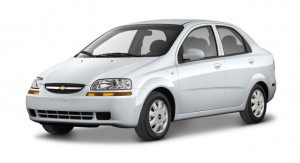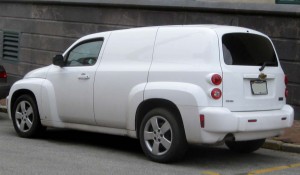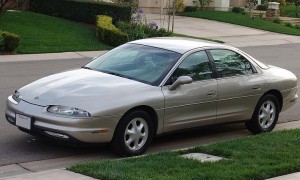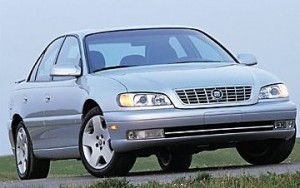GM Bad Idea: Chevrolet Aveo
Posted by Doug DeMuro in GM Bad Idea on | 9 comments
The “GM Bad Idea” segment usually calls out our friends at General Motors for obscure (often, unintentionally obscure) cars they build that were clearly a bad idea at every stage in development, from the first sketches to when the CEO sat inside one and announced: “Eh. Good enough. Not like we’re gonna go bankrupt or anything.”
The Chevrolet Aveo is just like that. But it isn’t obscure.
The Aveo came out in the US for the 2004 model year. I distinctly remember when it came out, because every single journalist realized immediately that it was outclassed, even back then. This didn’t stop GM from selling it, largely unchanged, for eight model years.
So what were the Aveo’s problems? Well: how much time do you have?
To me, the biggest was overall lack of refinement. I spent hours driving Aveos when I was employed for a summer by Enterprise Rent-a-Car, who loved the Aveo because they could buy it from Chevy for like four grand.
During those hours, I can’t remember how many times I had to adjust the radio to a higher volume simply because I was now on the highway. It wasn’t just noise: the ride was surprisingly awful and the steering wheel was constantly getting bounced around by rough roads. This may suggest that the Aveo handled well, but it didn’t, largely thanks to wheels the size of a Super Duty pickup’s center caps.
The problems weren’t confined to its driving experience. One of the Aveo’s biggest problems is that timing belts are notorious for breaking at around 50,000 miles. Fifty. Thousand. Miles. Fortunately, there’s no shortage of used Aveo engines from cars that were totaled after a light accident in a parking lot.
The Aveo was so bad that the second-generation car – still called Aveo in nearly every other market – had to be renamed Sonic for us North Americans. It’s a big improvement. But I’ll reserve full judgment until they start hitting the 50,000-mile mark.
Chevrolet HHR: GM Bad Idea
Posted by Doug DeMuro in GM Bad Idea on | 33 comments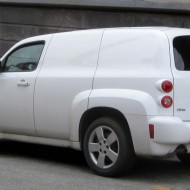
Remember the Chrysler PT Cruiser? I’d like to call that a “Chrysler bad idea,” but in reality, it wasn’t. The thing sold like crazy, and I still see them around, each in the hands of elderly people who are really pleased by them.
But the General Motors version was a bad idea. The Chevrolet HHR, which stood for ‘Heritage High Roof’ was a copy of the entire PT Cruiser idea, from the retro styling to the dull driving experience. It was even designed by the same person, Bryan Nesbitt, who joined GM after the PT Cruiser’s launch.
Chevrolet eventually decided to make a panel version of the HHR, which was also fairly bad, mainly because it didn’t have any rear exterior door handles. It did, however, have rear doors. They could only be opened from the inside, which was bizarre, because the HHR Panel didn’t have any rear seats.
Eventually, GM decided to get enthusiasts on board with the HHR by using the time-honored strategy of: “Throw as much power at it as you can.” This resulted in the 2008 HHR SS, which put 260 horsepower through its front wheels. Sadly, they didn’t make an HHR SS Panel, which would’ve been the fastest vehicle on the market without rear door handles.
Like the PT Cruiser, the HHR was eventually cancelled to the chagrin of fleet operators everywhere. Canada gets a newer version, dubbed the Orlando, but we Americans have to make do with nothing. I don’t think anyone’s really complaining about that.
1995 Oldsmobile Aurora: GM Bad Idea
Posted by Doug DeMuro in GM Bad Idea on | 13 comments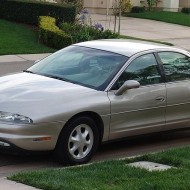
I haven’t done a “GM Bad Idea” segment in a while. This is not because GM has stopped having bad ideas. On the contrary, I have seen several new Cadillac XTSs on the road, and there’s absolutely no way they were purchased by anyone who didn’t receive an enormous GM incentive.
But I’m not here to knock the Cadillac XTS. That can be done in a future column. Instead, I’m going to call out another bad idea from our friends at General Motors: the Oldsmobile Aurora.
You may remember the original Aurora. It’s the car that resembles a rather large, windswept sand dune. It also had no grille, apparently under the theory that: it worked for the Ford Taurus in 1986, so it’ll work for us today.
Of course, it didn’t really work for GM in 1995, largely because buyers looked at it and thought: Hmm. That Oldsmobile looks different. Too bad it’s still an Oldsmobile. Then they instead purchased an Acura, or a Lexus, neither of which had yet made the swap from “normal-looking car” to “we must have a corporate grille and by God, it will be pointy.”
The Aurora was just as strange inside, by virtue of being one of those 1990s cars (and there were quite a few) that had an air vent on the door. It also had a dash that was curved towards the driver, though the material quality was such that most drivers probably wished it was a little further away.
We all know what happened to the Aurora: despite GM’s best intentions, the second-generation model was completely boring, and – eventually – the brand shut down for good. That was probably one of GM’s few good ideas. Still, I will always remember the Aurora fondly, provided I don’t think about it too hard.
Cadillac Catera: GM Bad Idea
Posted by Doug DeMuro in GM Bad Idea on | 8 comments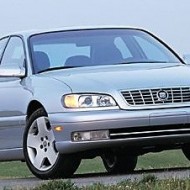
It seemed like a good idea at the time. A lot of my “GM Bad Idea” stories could start out that way, presumably except the Envoy XUV, which couldn’t have seemed like a good idea to anyone, but was probably cheap to build.
The Cadillac Catera is definitely an “it seemed like a good idea at the time” kind of car. In the late 1990s, Cadillac wanted younger buyers. This is totally understandable, since the Fleetwood Brougham was attracting the kind of people who thought: this vinyl roof looks spiffy!
But they didn’t want to do any real development work to attract younger buyers. The result was bringing over the rear-wheel drive European Opel Omega, throwing a Cadillac grille on the front, and marketing it to younger buyers. The marketing scheme included Cindy Crawford and a bright red duck named Ziggy, who had his own backstory:
He was one of six mythical, beakless, footless martins or “Merlettes” in the Cadillac Crest before we gave him big feet, a giant beak, and turned him around. He’s quite a departure from his five brothers who have been part of the Cadillac Crest since the days of the crusades when the crest was the proud symbol of Le Sieur Antoine de la Mothe Cadillac Family.
Strangely, Ziggy didn’t convince any young people to consider Cadillac, partly because the Catera’s 194-inch length was enormous by the standards of the day, and its 200-horsepower V6 was far from sporty. Still, Cadillac attempted a “Sport” model, which included, among other things, a three-channel garage door opener.
The Catera was facelifted in 2000, and Ziggy left the same year; the whole thing was shut down after the 2001 model year. Fortunately, in 2003, Cadillac actually did come out with a rear-wheel drive sedan that attracted younger buyers – but Ziggy was gone for good.
Chevrolet SSR: GM Bad Idea
Posted by Doug DeMuro in GM Bad Idea on | 11 comments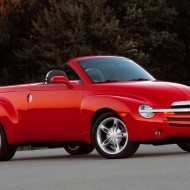
I know, I know. This one’s obvious. But you can’t have a section entitled “GM Bad Idea” and not mention the Chevrolet SSR.
To start, let’s go over the particulars. The Chevrolet SSR was a convertible pickup truck, apparently in the image of the Dodge Dakota convertible, because no other convertible pickup exists for comparison. This was strike one, since I imagine most convertible owners don’t often think: “I wish I could also use this to transport mulch.”
Not that they would’ve in the SSR. To accommodate the flared wheel arches, the bed was incredibly narrow, meaning nothing of actual substance could fit inside of it. Worse, all SSR beds had covers, which fit snugly over the top, making trunk space roughly equal to a midsize sedan. OK, fine, a large sedan. But not a Chevy Caprice Wagon.
When the SSR came out in 2003, it had a 300-horsepower V8 and a 4-speed automatic borrowed from various other SUVs. To piss off early buyers, Chevy added a stick shift and a 6.0-liter V8 that made 390 horsepower in 2005.
Interestingly, the SSR’s “muscle truck” image still didn’t manage to inspire any actual sales, and the thing was cancelled after the 2006 model year. And what was originally billed as the “world’s first convertible sport pickup truck” will no doubt fade into oblivion as the world’s only convertible sport pickup truck.
